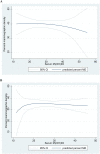Serum 25-Hydroxyvitamin D3 and Mammography Density among Mexican Women
- PMID: 27564705
- PMCID: PMC5001725
- DOI: 10.1371/journal.pone.0161686
Serum 25-Hydroxyvitamin D3 and Mammography Density among Mexican Women
Abstract
Low circulating levels of vitamin D and high mammographic density (MD) have been associated with higher risk of breast cancer. Although some evidence suggested an inverse association between circulating vitamin D and MD, no studies have investigated this association among Mexican women. We examined whether serum 25-hydroxyvitamin D3 [25(OH)D3] levels were associated with MD in a cross-sectional study nested within the large Mexican Teacher's Cohort. This study included 491 premenopausal women with a mean age of 42.9 years. Serum 25(OH)D3 levels were measured by liquid chromatography/tandem mass spectrometry. Linear regression and non-linear adjusted models were used to estimate the association of MD with serum 25(OH)D3. Median serum 25(OH)D3 level was 27.3 (23.3-32.8) (ng/ml). Forty one (8%) women had 25(OH)D3 levels in the deficient range (< 20 ng/ml). Body mass index (BMI) and total physical activity were significantly correlated with 25(OH)D3 (r = -0.109, P = 0.019 and r = 0.095, P = 0.003, respectively). In the multivariable linear regression, no significant association was observed between 25(OH)D3 levels and MD overall. However, in stratified analyses, higher serum 25(OH)D3 levels (≥27.3 ng/ml) were significantly inversely associated with percent MD among women with BMI below the median (β = -0.52, P = 0.047). Although no significant association was observed between serum 25(OH)D3 and percent MD in the overall population, specific subgroups of women may benefit from higher serum 25(OH)D3 levels.
Conflict of interest statement
The authors have declared that no competing interests exist.
Figures


Similar articles
-
Serum 25-hydroxyvitamin D and mammographic density in premenopausal Spanish women.J Steroid Biochem Mol Biol. 2019 May;189:101-107. doi: 10.1016/j.jsbmb.2019.03.004. Epub 2019 Mar 2. J Steroid Biochem Mol Biol. 2019. PMID: 30836177
-
Relationship of very low serum 25-hydroxyvitamin D3 levels with long-term survival in a large cohort of colorectal cancer patients from Germany.Eur J Epidemiol. 2017 Nov;32(11):961-971. doi: 10.1007/s10654-017-0298-z. Epub 2017 Sep 7. Eur J Epidemiol. 2017. PMID: 28884317
-
Dietary vitamin D intake is not associated with 25-hydroxyvitamin D3 or parathyroid hormone in elderly subjects, whereas the calcium-to-phosphate ratio affects parathyroid hormone.Nutr Res. 2013 Aug;33(8):661-7. doi: 10.1016/j.nutres.2013.05.011. Epub 2013 Jun 28. Nutr Res. 2013. PMID: 23890356
-
National Estimates of Serum Total 25-Hydroxyvitamin D and Metabolite Concentrations Measured by Liquid Chromatography-Tandem Mass Spectrometry in the US Population during 2007-2010.J Nutr. 2016 May;146(5):1051-61. doi: 10.3945/jn.115.227728. Epub 2016 Apr 6. J Nutr. 2016. PMID: 27052537 Free PMC article.
-
Vitamin D Status in Children With Short Stature: Accurate Determination of Serum Vitamin D Components Using High-Performance Liquid Chromatography-Tandem Mass Spectrometry.Front Endocrinol (Lausanne). 2021 Oct 13;12:707283. doi: 10.3389/fendo.2021.707283. eCollection 2021. Front Endocrinol (Lausanne). 2021. PMID: 34721288 Free PMC article.
Cited by
-
The Influence of Vitamin D on Mammographic Density: Results from CALGB 70806 (Alliance) a Randomized Clinical Trial.Cancer Prev Res (Phila). 2021 Jul;14(7):753-762. doi: 10.1158/1940-6207.CAPR-20-0581. Epub 2021 Apr 13. Cancer Prev Res (Phila). 2021. PMID: 33849913 Free PMC article. Clinical Trial.
References
-
- Assi V, Warwick J, Cuzick J, Duffy SW (2012) Clinical and epidemiological issues in mammographic density. Nat Rev Clin Oncol 9: 33–40 - PubMed
-
- White J (2000) Breast density and cancer risk: what is the relationship? J Natl Cancer Inst 92: 443 - PubMed
-
- Boyd NF, Rommens JM, Vogt K, Lee V, Hopper JL, Yaffe MJ, et al. (2005) Mammographic breast density as an intermediate phenotype for breast cancer. Lancet Oncol 6: 798–808 - PubMed
MeSH terms
Substances
Grants and funding
LinkOut - more resources
Full Text Sources
Other Literature Sources

